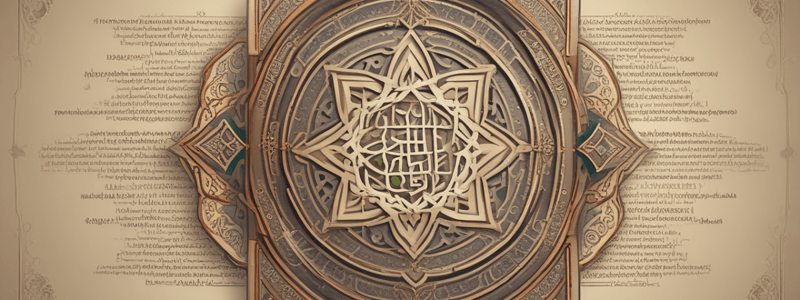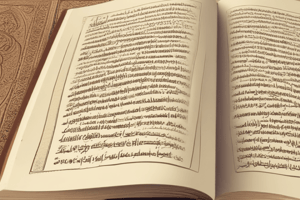Podcast
Questions and Answers
What is the significance of mentioning a full isnad and matn when narrating a hadith?
What is the significance of mentioning a full isnad and matn when narrating a hadith?
- It allows for differences in narrations to be clarified. (correct)
- It identifies weak narrators by analyzing their isnad.
- It guarantees that all narrators have the same viewpoint.
- It ensures the hadith is shortened for ease of understanding.
Why would a scholar reject the narrations of a 'Mudallis' if he used 'an'ana'?
Why would a scholar reject the narrations of a 'Mudallis' if he used 'an'ana'?
- Because 'Mudallis' often provides a complete isnad.
- Because it could mislead about the chain of transmission.
- Because the sheikh might not have been heard directly. (correct)
- Because the narration is always unreliable.
What role does clarifying 'Al-Mubham' serve in hadith studies?
What role does clarifying 'Al-Mubham' serve in hadith studies?
- It critiques the content of the hadith.
- It summarizes multiple hadith on the same topic.
- It distinguishes similar names among narrators. (correct)
- It identifies the strongest narrators in the isnad.
What does the repeated mention of a hadith indicate?
What does the repeated mention of a hadith indicate?
How do scholars approach the mistakes of 'Thiqaat' narrators?
How do scholars approach the mistakes of 'Thiqaat' narrators?
What is meant by 'strange asaneed and mutoon'?
What is meant by 'strange asaneed and mutoon'?
Flashcards are hidden until you start studying
Study Notes
Methodology of the Scholars of Hadith: As-Sihaah
- Full isnad (chain of narrators) and matn (text) of a hadith are prominently presented, followed by additional isnad that aligns with others in the chain.
- Comprehensive documentation of isnad and matn occurs, particularly when differing narrators impact meaning or introduce variations.
- Occasional references are made to other narrations sharing similar topics after presenting the main hadith with its isnad and matn.
- Repetition of hadith is utilized to support multiple issues, with some instances of shortened forms for conciseness.
- Stringent criteria are applied to authenticate hadith; any slight criticism of the isnad results in rejection of the hadith's authenticity.
- Narrators labeled as 'Mudallis' are critiqued; if they employ 'an'ana (a term denoting indirect narration) from a sheikh whom they couldn't directly hear from, the narration is dismissed.
- Critical evaluation of narrators is essential; this includes confirming whether a narrator genuinely heard a hadith from their sheikh and clarifying ambiguities, particularly 'Al-Mubham' (unknown narrators).
- Errors among reliable narrators ('Thiqaat') are highlighted, distinguishing clear mistakes from those that are less obvious in the transmission of hadith.
- Emphasis on differentiating wording variations among narrators, which can influence the interpretation of hadith.
- Attention is directed towards unusual isnad and matn, providing clarity on their significance within Islamic tradition.
Studying That Suits You
Use AI to generate personalized quizzes and flashcards to suit your learning preferences.




